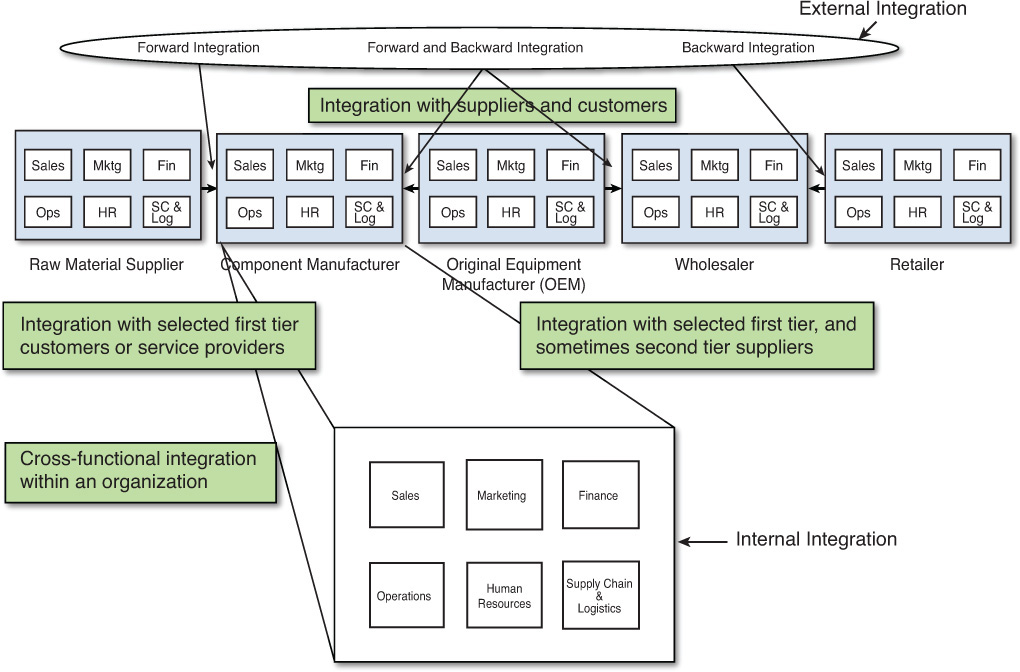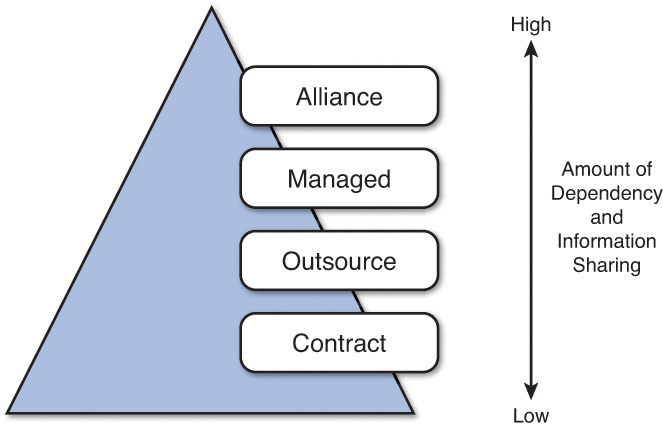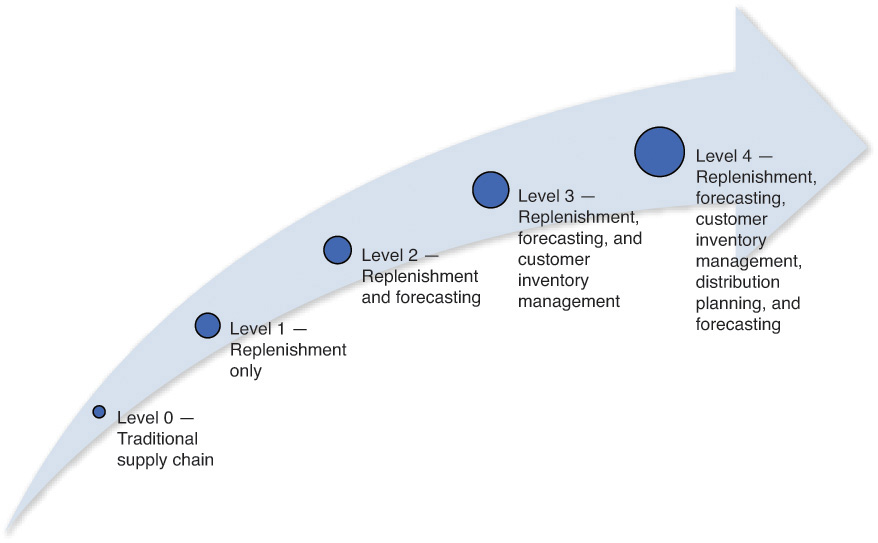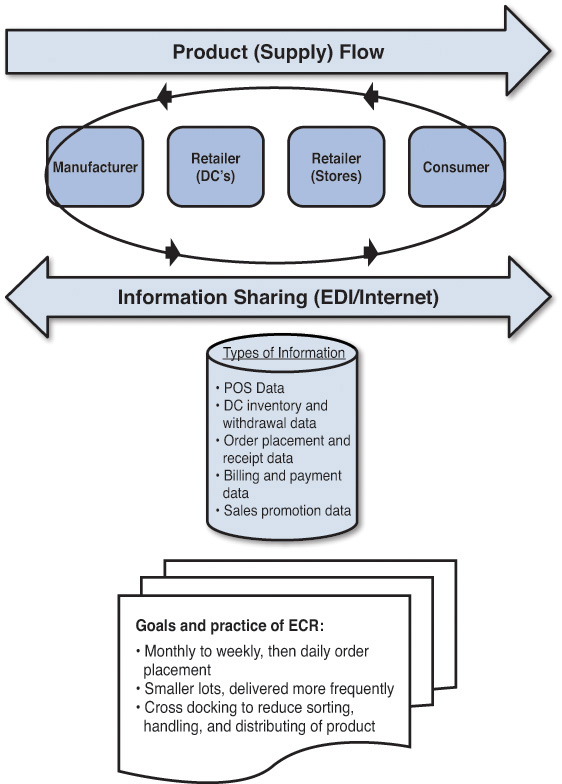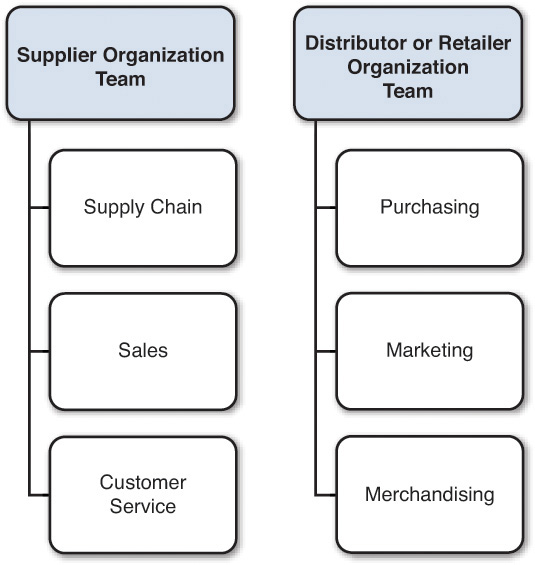13. Supply Chain Integration Through Collaborative Systems
Supply chain integration refers to the degree to which the firm can strategically collaborate with their supply chain partners and collaboratively manage the intra- and interorganization processes to achieve the effective and efficient flows of product and services, information, money, and decisions (see Figure 13.1). The objective of this integration is to provide the maximum value to the customer at low cost and high speed.
Integration is not the same as collaboration, as integration is the alignment and linking of business processes and includes various communication channels and connections within a supply network. Collaboration, in contrast, is a relationship between supply chain partners that is developed over time. Integration is possible without collaboration, but it can be an enabler of collaboration.
There are two general categories of business integration: internal and external, which we will now explore.
Internal and External Integration
Internal Integration

Understanding the entire supply chain of an organization begins with understanding its internal processes, because an integrated firm presents a united front to customers, suppliers, and competitors.
As the saying goes, “A chain is only as strong as its weakest link.” So, it is critical that there are good communications, policies, and procedures that link not only the internal supply chain processes with each other but also with the other major functions within the organization.
In general, purchasing, operations, and logistics are responsible for delivering the product to the customer. Purchasing is a gatekeeper for process inputs, operations transform raw materials into final product, and logistics is responsible for physical transfer and delivery.
Internal supply chain integration therefore is a process of interaction and collaboration in which manufacturing, purchasing, and logistics work together in a cooperative manner to arrive at mutually acceptable outcomes for their organization.
It is important to integrate communications and information systems so as to optimize their effectiveness and efficiency, and this can be achieved by structuring the organization and the design and implementation of information systems where non-value-adding activity is minimized; costs, lead times, and functional silos are reduced; and service quality is improved.
Many organization’s today use process improvement tools such as Lean and Six Sigma (and the combination of the two known as Lean Six Sigma, covered later in this book) to analyze existing organizational structures, eliminate non-value-adding activities, and implement new work structures so that the organization is optimally aligned.
An integrated enterprise resource planning (ERP) is a key enabler of internal integration, often exposing remaining non-value-added activities in the organization and allowing for better communication and collaboration through a common database.
Internal integration needs more than a system and proper organization. It also needs the following:
![]() Shared goals: Which refers to the extent to which the manager of each key function (purchasing, operations, and logistics) is familiar with the strategic goals of each of the other two focal functions
Shared goals: Which refers to the extent to which the manager of each key function (purchasing, operations, and logistics) is familiar with the strategic goals of each of the other two focal functions
![]() Cooperation: Measured by the frequency of requests from other focal functions fulfilled by the members of each focal function
Cooperation: Measured by the frequency of requests from other focal functions fulfilled by the members of each focal function
![]() Collaboration: Defined as the frequency at which a member of a key function actively works on issues with members from the other key functions
Collaboration: Defined as the frequency at which a member of a key function actively works on issues with members from the other key functions
External Integration

External or interorganization integration involves the sharing of product and service information and knowledge between organizations in a supply chain. Like internal integration, it also requires shared goals, cooperation, and collaboration to work successfully.
This enables all stages of the supply chain to take actions that are aligned and increase total supply chain surplus (that is, the difference between revenue less cost to produce and deliver product to the customer).
It requires that each stage in the entire supply chain share information and take into account the effects of its actions on the other stages.
If the objectives of the different stages conflict with each other or information moving between stages is delayed or distorted, lack of coordination will result, resulting in the bullwhip effect described earlier in Chapter 2, “Understanding the Supply Chain.”
Successful collaboration relies on the development of mutual trust between you and your partners, as well as the willingness to share information (electronically and manually) that can benefit all the members of your collaborative team. The goal is to treat all suppliers, outsourcing partners, customers, and service providers as an extension of your organization.
Supply Chain Collaboration by Industry
Many industries are experimenting with supply chain collaboration, adapting the concept to fit their specific needs.
For example, consumer products and retail companies are implementing safety stock levels across their entire supply chains. Using point of sale (POS) and other information sources, these companies have increased service levels all the way to the store level.
Pharmaceutical and automotive industries have used collaboration to prevent counterfeit products from getting into their supply chains. For example, pharmacies are using radio frequency identification (RFID) to better manage the shelf life of perishable coded products.
High-tech space are looking to get production visibility beyond purchase-level response, to better control quality, cost, and availability to improve measurements of customer service such as customer request date.
Capital equipment and manufacturing companies are leveraging collaboration technologies to extend Lean supply chain principles across the enterprise by extending electronic kanban processes (that is, Lean technique to visually replenish inventory based on downstream demand) to suppliers.
Levels of External Collaboration
Across all industries, supply chain collaboration operates at the strategic, tactical, and execution level:
![]() Strategic: At this level, organizations and their partners make joint decisions on strategic issues such as production capacities, product design, production facility and fulfillment network expansion, portfolio joint marketing, and pricing plans.
Strategic: At this level, organizations and their partners make joint decisions on strategic issues such as production capacities, product design, production facility and fulfillment network expansion, portfolio joint marketing, and pricing plans.
![]() Tactical: This level involves sharing information with partners on topics such as forecasts, production, and transportation plans and capacities, bills of material, orders, product descriptions, prices and promotions, inventory, allocations, product and material availability, service levels, and contract terms such as supply capacity, inventory, and services.
Tactical: This level involves sharing information with partners on topics such as forecasts, production, and transportation plans and capacities, bills of material, orders, product descriptions, prices and promotions, inventory, allocations, product and material availability, service levels, and contract terms such as supply capacity, inventory, and services.
![]() Execution: At this level, organizations and their partners engage in an integrated exchange of key transactional data such as purchase orders, production/work orders, sales orders, POS information, invoices, credit notes, debit notes, and payments (SAP, 2007).
Execution: At this level, organizations and their partners engage in an integrated exchange of key transactional data such as purchase orders, production/work orders, sales orders, POS information, invoices, credit notes, debit notes, and payments (SAP, 2007).
Types of External Collaboration
External collaboration can range from relatively simple to very complex based on the amount of dependency and information sharing between parties (see Figure 13.2).
The simplest form of collaboration is contracting, which adds a time dimension to traditional buying and selling (that is, having price, service, and performance expectations over specific period).
The next level of collaboration is outsourcing, which shifts the focus from just buying materials to actually performing a specific service or activity.
After that comes what could be referred to as managed types of collaboration, where a dominate company uses a command and control system to direct the partner and there is limited sharing of strategic information and limited joint planning. This type of relationship has no specific time frame to it (that is, termination/rebid).
The most advanced forms of collaboration are alliances such as we’ve seen with Dell and its suppliers in a just-in-time (JIT) environment, where the parties voluntarily work together both strategically and operationally and there is an integration of human, financial, operational, and technical resources. There is an extensive amount of joint planning and anticipation of a long-term relationship.
As companies move along this path toward alliances, trust is a key component. Trust does not occur overnight; it requires ongoing interaction among organizations. It is necessary to first see reliability in operations and then a gradual sharing of all information for the relationship to function properly. Trust can be maintained by being open and honest with regard to key decisions (often referred to somewhat tongue in cheek as opening your kimono).
It is helpful to look at the types of external collaboration in terms of those with both suppliers and customers and the importance of integrating the sales & operations planning (S&OP) process to include information from both sources.
Supplier Collaboration
Some of the types of supplier collaboration include the following:
![]() Kanban: A signal-based replenishment process used in Lean or JIT production that uses cards or other visual signals such as a line on a wall to signal the need for replenishment of an item.
Kanban: A signal-based replenishment process used in Lean or JIT production that uses cards or other visual signals such as a line on a wall to signal the need for replenishment of an item.
Using collaborative technologies, the kanban process allows customers to electronically issue the kanban replenishment signals to their suppliers, who can then determine requirements and see exceptions.
![]() Dynamic replenishment: This is a process that where suppliers compare customer forecasts or production schedules with their own production plans to match supply and demand. It allows suppliers to adjust to changes in customer requirements or supply shortages.
Dynamic replenishment: This is a process that where suppliers compare customer forecasts or production schedules with their own production plans to match supply and demand. It allows suppliers to adjust to changes in customer requirements or supply shortages.
![]() Invoicing processes: Automating invoicing and related processes gives the visibility to the vendor for the entire supply side, including purchase orders, releases, supplier-managed inventory, kanbans, and dynamic replenishment.
Invoicing processes: Automating invoicing and related processes gives the visibility to the vendor for the entire supply side, including purchase orders, releases, supplier-managed inventory, kanbans, and dynamic replenishment.
![]() Outsourced manufacturer collaboration: When managing outsourced manufacturing relationships or contract manufacturers, you must shift your focus from owning and organizing assets to working collaboratively with partners.
Outsourced manufacturer collaboration: When managing outsourced manufacturing relationships or contract manufacturers, you must shift your focus from owning and organizing assets to working collaboratively with partners.
The collaborative efforts should help simplify processes such as product development and reduce manufacturing costs and improve reaction to response to customer demand.
Any efforts to automate these processes should support information sharing, collaboration, and monitoring activities that are needed to effectively manage the relationship with a contract manufacturer.
Customer Collaboration
Customer collaboration involves the receiving demand signals and automatically replenishing the customer’s inventory based on actual demand. This is seen primarily in consumer products and other industries that have downstream distribution systems that extend to retailers.
This type of integration and collaborative effort enables manufacturers to shift from a push system to a demand pull supply chain while combining both forecasts and actual customer demand.
Collaborative replenishment processes are more responsive than purely forecast-based processes, and because they are driven largely by actual customer demand and also provide visibility in out-of-stock situations, manufacturers and retailers can react more quickly. Several of these are discussed later in the chapter and go by the names quick response (QR) and efficient consumer response (ECR). POS information can add visibility across the entire supply chain, as well, when included in a collaborative replenishment process.
Another type of customer collaboration that focuses on forecasts is known as collaborative planning, forecasting, and replenishment (or CPFR, which is a trademark of the Voluntary Inter-industry Commerce Standard Association [VICS]). It is an outgrowth from some of the earlier customer replenishment initiatives such as QR and ECR.
In general, CPFR is an attempt to reduce supply chain costs by promoting greater integration, visibility, and cooperation between trading partners’ supply chains. It combines the intelligence of multiple trading partners in the planning and fulfillment of customer demand.
Figure 13.3 shows collaborative or vendor-managed inventory configurations in terms of the level of sophistication or complexity. Levels 1 and 2 have been implemented in various industries and would include programs such as QR and ECR. Levels 3 and 4 are more advanced and would include CPFR-like programs.
Sales & Operations Planning
S&OP, discussed in Chapter 4, “Inventory Planning and Control,” allows you to introduce collaborative information into the decision-making process, and when used as part of your collaborative efforts, it enables better communications between cross-functional groups and trading partners, both customers and suppliers.
Globalization and outsourcing generate a lot of information that can impact an organization’s decision-making process externally to the enterprise. As a result of this, a comprehensive S&OP process is even more important. The S&OP process makes sure that your business is continually managed to meet organizational strategies, goals, and commitments, despite ongoing changes in your environment.
Benefits to Collaboration
Increased connectivity and collaboration between companies and their trading partners creates many benefits for both suppliers and your customers, such as the following:
![]() Higher inventory turns
Higher inventory turns
![]() Lower fulfillment (transportation and warehousing) costs
Lower fulfillment (transportation and warehousing) costs
![]() Lower out-of-stock levels and improved customer service
Lower out-of-stock levels and improved customer service
![]() Shorter lead times
Shorter lead times
![]() Early identification of changes to demand and improved market intelligence
Early identification of changes to demand and improved market intelligence
![]() Visibility into customer demand and supplier performance
Visibility into customer demand and supplier performance
![]() Earlier and faster decision making (SAP, 2007)
Earlier and faster decision making (SAP, 2007)
Supply Chain Collaboration Methods: A Closer Look
A variety of supply chain collaboration methods or models have been used during the past 25 years or so. Some overlap exists between some of them, and there is some confusion as to their (somewhat subtle) differences.
The following subsections describe some of the major methods.
Quick Response
Quick response (QR) was an apparel manufacturing initiative that started primarily in the United States during the mid-1980s. The main objective of QR was to drastically reduce lead times and setup costs to allow the postponement of ordering decisions until right before, or during, the retail selling season, when better demand information might be available.
Implementation of QR is typically used in conjunction with information technologies such as electronic data interchange (EDI; a standardized format for businesses to exchange data electronically), barcodes, and RFID (the wireless use of radio frequency signals to transfer data to identify and track tags attached to objects).
A QR strategy can result in efficiencies such as maximized diversity of offering, quicker deliveries, faster inventory turns, fewer stock-outs, fewer markdowns, and lower inventory investment.
This type of strategy can also reduce the time between the sale and replacement of goods on the retailer’s shelf because it places an emphasis on flexibility and product velocity to meet the changing requirements of a highly competitive and dynamic marketplace.
Efficient Consumer Response
Efficient Consumer Response (ECR), launched in 1984, is a grocery sector joint trade and industry organization with the goal of making the industry more responsive to consumer demand and to remove unnecessary costs from the supply chain.
The thinking is to improve the efficiency of a supply chain as a whole beyond the wall of retailers, wholesalers, and manufacturers, so that they can gain larger profits than each pursuing their own business goals.
One of the main practices used in ECR is to place smaller orders more often to shorten lead times, improve inventory turns, and reduce stock outs (see Figure 13.4). ECR is similar to QR except that it is targeted toward the grocery industry, where the supplier takes responsibility of monitoring and replenishing the retailer’s distribution center inventories with approval of the retailer.
In the 1990s, when I was with Church and Dwight (Arm & Hammer products), we successfully implemented an ECR program to both place orders for and manage the inventory of our products at the distribution centers of a number of our grocery clients, including Wakefern (that is, ShopRite) and H. E. Butt.
Like QR, ECR is highly dependent on technology, using tools such as EDI, forecasting, and distribution requirements planning (DRP) software and point-of-sale (POS) data to manage the process.
The use of sophisticated technology like this as well as the lack of capabilities (both skill and technology related), the resistance of wholesalers, retailers, and manufacturers toward collaboration, and the attitudes of company personnel can all be barriers to a successful implementation of an ECR (or QR) type of program. It is well worth the effort, though, and can prove to be a win-win for all involved, because forecast accuracy tends to improve for the manufacturer and the retailer is relieved of managing the replenishment of some of its over 50,000+ stock keeping units (SKUs) while reducing stock-outs and inventory and ordering costs.
Collaborative Planning, Forecasting, and Replenishment
Collaborative planning, forecasting, and replenishment (CPFR) is a form of collaboration that combines knowledge and information from multiple trading partners to reduce supply chain costs and improve efficiencies by linking sales and marketing best practices to supply chain planning and execution processes. Its overall objective is to increase customer service while reducing inventory, transportation, and logistics costs.
CPFR has its roots in efficient consumer response (ECR) and is an attempt to improve marketing, production, and replenishment functions, resulting in increased value to the consumer while at the same time improving supply chain performance for producers and retailers.
The Voluntary Inter-industry Commerce Solutions (VICS) association has defined both a framework and guidelines for CPFR, including elements for strategy and planning used for the development of joint business plans and the forms of collaboration, supply chain management focusing on forecasting and order planning, execution for the fulfillment of replenishment orders, and analysis for exceptions and performance metrics.
The benefits of CPFR can include the following:
![]() Improved forecast accuracy
Improved forecast accuracy
![]() Smoother ordering patterns
Smoother ordering patterns
![]() Increased sales revenues
Increased sales revenues
![]() Higher order-fill rates
Higher order-fill rates
![]() Decrease in safety stock inventory levels
Decrease in safety stock inventory levels
![]() Reduction in cost of goods sold (COGS) as a result of improved visibility of end-consumer demand, more accurate forecasts, and more stable production schedules
Reduction in cost of goods sold (COGS) as a result of improved visibility of end-consumer demand, more accurate forecasts, and more stable production schedules
Similarly to QR and ECR, CPFR requires the use of technology, which can be shared technology, for planning, execution, and measurement.
As in most cases of intercompany integration and collaboration, besides having sophisticated supply chain processes and technology, the key is to have the proper organization alignment and training (see Figure 13.5).
On the supplier side, there will need to be CPFR teams made up of supply chain, sales, and customer service employees. On the customer side, which can be either the distributor or retailer, representatives from the purchasing, marketing, and merchandising functions will also need to be organized into a focused CPFR team.
Internal processes such as S&OP will have to be integrated with the CPFR process, and education initiatives are needed to make sure everyone understands and buys in to CPFR and its processes, as well as the implications of the coming change, benefits of CPFR, and the strategic importance of this type of initiative (Andrews, 2008).
Now that you understand how technology is a critical enabler of an effective supply chain (as discussed throughout the whole book), it is now time to take a closer look in the next chapter.

